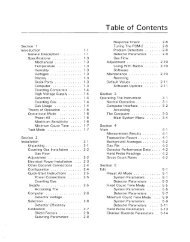Rad Data Handbook 20.. - Voss Associates
Rad Data Handbook 20.. - Voss Associates
Rad Data Handbook 20.. - Voss Associates
Create successful ePaper yourself
Turn your PDF publications into a flip-book with our unique Google optimized e-Paper software.
NEUTRON SHIELD THICKNESS<br />
I = I0e -Nx<br />
where; I = final neutron flux rate<br />
I 0 = initial neutron flux rate<br />
= shield cross section in square centimeters<br />
N<br />
3<br />
= number of atoms per cm in the shield<br />
x = shield thickness in centimeters<br />
example:<br />
A dosimetry phantom is designed to simulate the<br />
composition of the human body. Ten % by weight is<br />
hydrogen. Assume a density of 1 and a shield cross<br />
section of hydrogen of 0.1 barns. A barn is 1E-24<br />
2 3<br />
cm . N, the number of atoms per cm , is 10% of<br />
Avogadro’s number, so N equals 6E22 hydrogen<br />
3<br />
atoms per cm . Assume the phantom thickness is<br />
30 cm.<br />
2<br />
I 0 = 5,000 n/cm /s<br />
2<br />
= 1E-25 cm (0.1 barns)<br />
N = 6E22 atoms per cm 3<br />
x = 30 centimeters thick<br />
-Nx = 1E-25 times 6E22 times 30 = -0.18<br />
I = I0e -Nx<br />
2 -0.18<br />
I = 5,000 n/cm /s e<br />
2 2<br />
I = 5,000 n/cm /s x 0.835 = 4,175 n/cm /s<br />
The attenuation of the neutron flux by the phantom is<br />
about 16%.<br />
59<br />
NEUTRON SHIELD THICKNESS<br />
I = I0e -Nx<br />
where; I = final neutron flux rate<br />
I 0 = initial neutron flux rate<br />
= shield cross section in square centimeters<br />
N<br />
3<br />
= number of atoms per cm in the shield<br />
x = shield thickness in centimeters<br />
example:<br />
A dosimetry phantom is designed to simulate the<br />
composition of the human body. Ten % by weight is<br />
hydrogen. Assume a density of 1 and a shield cross<br />
section of hydrogen of 0.1 barns. A barn is 1E-24<br />
2 3<br />
cm . N, the number of atoms per cm , is 10% of<br />
Avogadro’s number, so N equals 6E22 hydrogen<br />
3<br />
atoms per cm . Assume the phantom thickness is<br />
30 cm.<br />
2<br />
I 0 = 5,000 n/cm /s<br />
2<br />
= 1E-25 cm (0.1 barns)<br />
N = 6E22 atoms per cm 3<br />
x = 30 centimeters thick<br />
-Nx = 1E-25 times 6E22 times 30 = -0.18<br />
I = I0e -Nx<br />
2 -0.18<br />
I = 5,000 n/cm /s e<br />
2 2<br />
I = 5,000 n/cm /s x 0.835 = 4,175 n/cm /s<br />
The attenuation of the neutron flux by the phantom is<br />
about 16%.<br />
59<br />
NEUTRON SHIELD THICKNESS<br />
I = I0e -Nx<br />
where; I = final neutron flux rate<br />
I 0 = initial neutron flux rate<br />
= shield cross section in square centimeters<br />
N<br />
3<br />
= number of atoms per cm in the shield<br />
x = shield thickness in centimeters<br />
example:<br />
A dosimetry phantom is designed to simulate the<br />
composition of the human body. Ten % by weight is<br />
hydrogen. Assume a density of 1 and a shield cross<br />
section of hydrogen of 0.1 barns. A barn is 1E-24<br />
2 3<br />
cm . N, the number of atoms per cm , is 10% of<br />
Avogadro’s number, so N equals 6E22 hydrogen<br />
3<br />
atoms per cm . Assume the phantom thickness is<br />
30 cm.<br />
2<br />
I 0 = 5,000 n/cm /s<br />
2<br />
= 1E-25 cm (0.1 barns)<br />
N = 6E22 atoms per cm 3<br />
x = 30 centimeters thick<br />
-Nx = 1E-25 times 6E22 times 30 = -0.18<br />
I = I0e -Nx<br />
2 -0.18<br />
I = 5,000 n/cm /s e<br />
2 2<br />
I = 5,000 n/cm /s x 0.835 = 4,175 n/cm /s<br />
The attenuation of the neutron flux by the phantom is<br />
about 16%.<br />
59<br />
NEUTRON SHIELD THICKNESS<br />
I = I0e -Nx<br />
where; I = final neutron flux rate<br />
I 0 = initial neutron flux rate<br />
= shield cross section in square centimeters<br />
N<br />
3<br />
= number of atoms per cm in the shield<br />
x = shield thickness in centimeters<br />
example:<br />
A dosimetry phantom is designed to simulate the<br />
composition of the human body. Ten % by weight is<br />
hydrogen. Assume a density of 1 and a shield cross<br />
section of hydrogen of 0.1 barns. A barn is 1E-24<br />
2 3<br />
cm . N, the number of atoms per cm , is 10% of<br />
Avogadro’s number, so N equals 6E22 hydrogen<br />
3<br />
atoms per cm . Assume the phantom thickness is<br />
30 cm.<br />
2<br />
I 0 = 5,000 n/cm /s<br />
2<br />
= 1E-25 cm (0.1 barns)<br />
N = 6E22 atoms per cm 3<br />
x = 30 centimeters thick<br />
-Nx = 1E-25 times 6E22 times 30 = -0.18<br />
I = I0e -Nx<br />
2 -0.18<br />
I = 5,000 n/cm /s e<br />
2 2<br />
I = 5,000 n/cm /s x 0.835 = 4,175 n/cm /s<br />
The attenuation of the neutron flux by the phantom is<br />
about 16%.<br />
59













